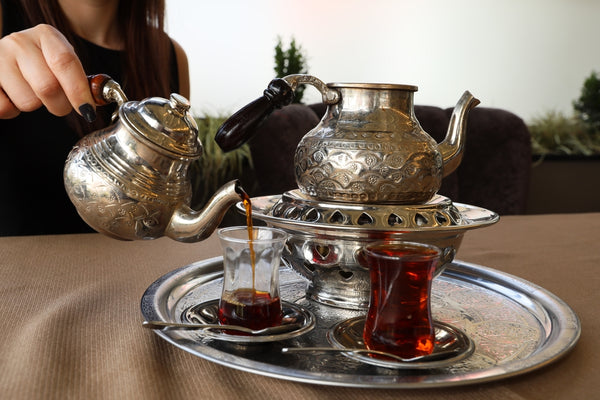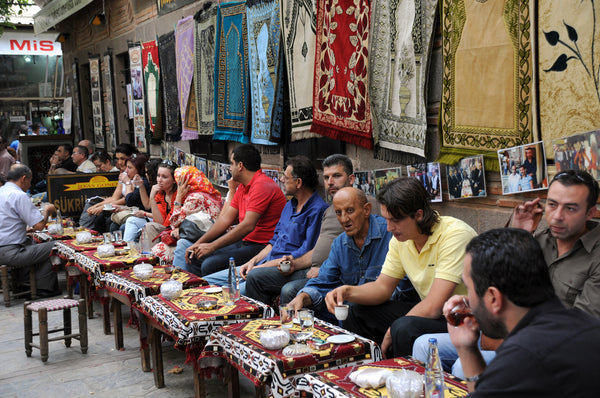There is something about tea and Eastern cultures that just click together.
In our previous posts, we explored how tea penetrated countries from Morocco through Russia to Iran. We witnessed the birth and evolution of those countries' unique tea cultures and how they intertwined and influenced each other. Today, we round up our round-the-world journey in Turkey to explore the local tea heritage and traditions around tea.
Let's start with a unanimous fact – Turkey crowns the Top 10 list of tea-drinking countries in the world (based on per capita consumption)! It's hard to imagine tea entered this country a mere century ago. Yet, tea culture in Turkey has a long and rich history. Since its introduction, tea has become an important part of Turkish daily life. Today, it is an integral part of the social culture. Serving and drinking tea together is also a way of showing hospitality. It is common for Turkish people to offer tea to guests as a sign of goodwill and being welcome.
Tea heritage in Turkey – legends vs reality
There are a couple of beautiful legends about tea heritage in Turkey. One tells about a wise herbalist who lived in the mountains. He would take long walks in the hills every day to collect medicinal plants.
One day, while walking in the mountains, he saw a flock of birds sitting on a bush. As he approached the bush, he saw that the birds were eating the leaves of the bush and seemed to be greatly enjoying them. Intrigued, he collected some leaves and took them home to study.
The wise man examined the leaves and discovered they had a wonderful aroma and flavor when steeped in hot water. He began experimenting with the leaves, drying and grinding them into a fine powder. Eventually, he created a drink that he called "çay" (tea).
The village people were amazed by the new drink. They began to spread the word about the wise man's discovery. Soon, tea became a popular beverage throughout Turkey, celebrated as a symbol of wisdom and ingenuity.
Another tale related to Turkish tea heritage is the story of the "seven cups of tea." According to this legend, if you visit a Turkish household, the host will offer you a cup of tea as a sign of hospitality. However, the tradition goes beyond just one cup of tea.
The host will usually offer you a second cup of tea. This is to help wash away the tiredness of your journey. The third cup of tea is meant to help you forget any worries or stresses you may carry with you. The fourth cup of tea is said to bring pleasure and happiness, while the fifth cup is believed to help you feel refreshed and energized.
The sixth cup of tea is said to bring a sense of calm and peace, while the seventh and final cup of tea is meant to be a sign of thanks and farewell to the guest, indicating that it is time to leave.
Many of our attentive readers would notice the similarity with the famous Tang dynasty poem "Seven cups of tea" written by Lu Tong (sometimes called "the second sage of tea" after Lu Yu). Let's remind it here:
Lu Tong's Seven Bowls of Tea (七碗诗, 卢仝, 唐, 790~835):
The first bowl moistens my lips and throat; 一碗喉吻潤,
The second bowl breaks my loneliness; 二碗破孤悶,
The third bowl searches my barren entrails but to find 三碗搜枯腸,
Therein some five thousand scrolls; 惟有文字五千卷,
The fourth bowl raises a slight perspiration 四碗發輕汗,
And all life's inequities pass out through my pores; 平生不平事盡向毛孔散,
The fifth bowl purifies my flesh and bones; 五碗肌骨清,
The sixth bowl calls me to the immortals. 六碗通仙靈,
The seventh bowl could not be drunk, 七碗吃不得也,
only the breath of the cool wind raises in my sleeves. 唯覺兩腋習習清風生。
Where is Penglai Island, Yuchuanzi wishes to ride on this sweet breeze and go back. 蓬萊山,在何處,玉川子乘此清風欲歸去。

As legends are often rooted in actual circumstances, this similarity suggests the Chinese influence on tea entering Turkey. Let's explore the history of the tea introduction to Turkey in greater detail.
The ambassadors of tea in Turkey
Tea was introduced to Turkey in the late 1800s and early 1900s when the Ottoman Empire underwent significant political and cultural changes. During this time, Turkish diplomats and traders were traveling to China and other parts of Asia. There, they discovered tea and brought it back to Turkey.
Interestingly, the first tea seedlings entered Turkey not from China but from Japan. The credit for this goes to Kamil Pasha, a prominent Ottoman statesman and diplomat. He served as the Ottoman ambassador to Japan from 1890 to 1895. During his time in Japan, Kamil Pasha became acquainted with Japanese tea culture and recognized the potential of tea as a beverage for Turkey. He brought back with him tea seeds and samples of green tea. Then, he established the first tea plantation in the Black Sea region of Turkey, near Rize.
Kamil Pasha also began promoting tea consumption in the Ottoman Empire, encouraging people to drink tea instead of coffee, the dominant hot beverage at the time. He even gave tea as gifts to Ottoman officials and foreign dignitaries, helping to spread the popularity of tea. In the early years, tea was considered a luxury item, consumed primarily by the wealthy elite. However, its popularity quickly grew, making it more widely available and accessible to the masses.
Fast forward 40 years, and the government has already recognized the potential of the tea plant. In the 1930s, the Turkish government ordered a study of the Black Sea region's agricultural potential. The man appointed to lead it was Osman Sağdıç, a Turkish agronomist. During his research, he realized that the region's climate and soil were ideal for tea cultivation. Osman Sağdıç encouraged local farmers to begin growing tea. He provided them with tea seedlings and gave technical advice on how to cultivate and process the leaves. Through his efforts, the cultivation of tea began to spread in the region. That led to the establishment of the first tea factory in Turkey in Rize in 1947.
Making tea in Turkey
Compared to her consumption numbers, the tea production in Turkey is on a smaller scale. According to a FAO report (the Food and Agriculture Organization of the United Nations), Turkey is the 6th largest tea producer in the world.
Since the founding of the country's first tea factory, the Eastern Black Sea region with its warm and humid climate has remained home to most of Turkey's tea production. The country produces, consumes and exports almost exclusively black tea. The tea grows on terraced hillsides, with small-scale farmers carrying out most of the production. The tea harvest in Turkey usually takes place between May and October. Workers pick the tea leaves mostly by hand. After harvesting the leaves, they take them to processing facilities for drying, sorting, and packaging.
The ever increasing demand for tea makes Turkey import as much as 1,3 times more tea than it produces. It is also the cause of the relatively small export – a mere 4% of the total tea production goes for export. Its main markets are in Europe and the US, where Turkish tea has a high reputation.
Drinking tea in Turkey
Tea culture in Turkey is steeped in tradition. It is a cherished part of the country's cultural heritage. Whether consumed at home with friends and family or in a local tea house, tea is integral to daily life in Turkey. It remains a symbol of hospitality, friendship, and community through the ages.
Local customs
The traditional way of making tea in Turkey uses a double tea kettle system known as çaydanlık. You guessed it, that is another form of "samovar" (самовар). This Russian invention found its way to Turkey through the trading roads. Here, it took a new life, blending with the local tea customs. The çaydanlık consists of two main parts: the lower kettle that holds boiling water and the upper kettle for the loose tea leaves. The tea is poured back and forth between the two kettles to create a frothy and flavorful tea.

The host serves tea in small glasses that they usually fill, leaving only about a quarter to a third empty. Tea is traditionally accompanied by beet sugar cubes on the side.
Much like China, Japan, Iran, and Morocco, Turkish tea heritage includes their own version of a tea house. They are known as çay bahçesi, or "tea garden." These tea gardens are typically outdoor spaces where people can sit, relax, and enjoy a hot cup of tea with friends, family, or colleagues.
Çay bahçesi are especially popular in big cities, where people often go to escape the hustle and bustle of the city and enjoy some quiet time with a cup of tea. Many of these tea gardens also serve other drinks and snacks, such as Turkish coffee, fresh juices, and small sandwiches.
Çay bahçesi is a very casual and laid-back environment. It is common for people to spend hours at a time chatting, playing games, or just people-watching. It is also a place where people from all walks of life can come together and enjoy life's simple pleasures. In many ways, çay bahçesi is a reflection of Turkish culture, which values community, hospitality, and a relaxed approach to life.

* traditional tea house in Izmir, Turkey
Turkish tea heritage – drink tea like a local
Turkish tea heritage has taken shape in their own version of a tea ceremony, known as "çay otu". This ceremony involves carefully pouring the tea from the upper kettle into the glasses to create a frothy and well-mixed tea. The person performing the ceremony is usually an experienced tea pourer who takes great care to pour the tea with a steady hand, in a specific pattern, and at just the right temperature.
The tea-pouring ceremony is seen as a symbol of hospitality and generosity and is often performed for guests or visitors. It is considered a sign of respect and an opportunity to demonstrate one's tea-pouring skills and knowledge of tea culture. In some rural communities, the tea-pouring ceremony is even used to settle disputes and resolve conflicts, as the act of sharing a cup of tea is a sign of goodwill and mutual understanding.
Today, tea is an integral part of daily life in Turkey, consumed by people of all ages and backgrounds. It is widely available in local tea houses, in homes, and on the streets and is often served in small glasses with beet sugar cubes on the side. The tradition of drinking tea has become an important part of Turkish culture and social life and is a symbol of hospitality, friendship, and community.